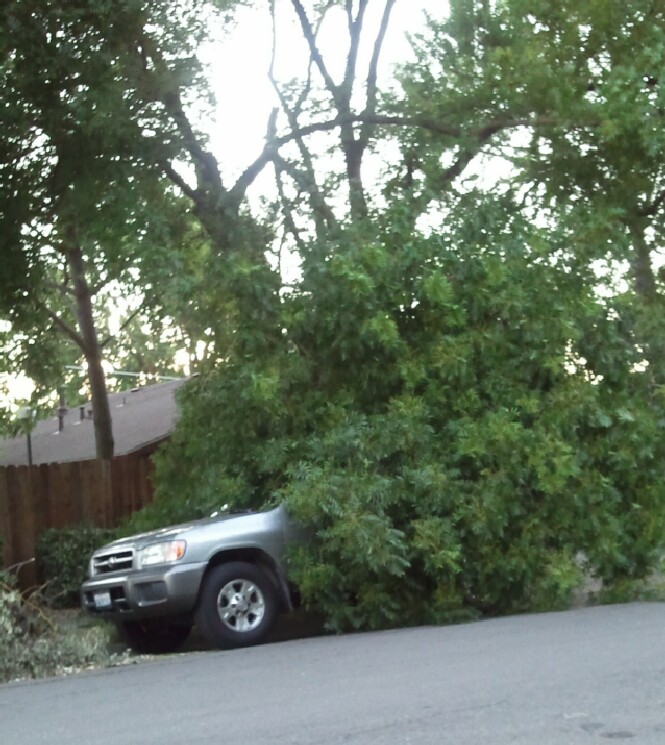
One of the cuts to the city budget in Tier 2 is the reduction of the street tree maintenance contract, which among other things would eliminate the portion of the contract for trees at residential addresses.
The savings to the city for this is a mere $25,000. While we focused heavily on supporting the city council’s proposal to restore funding for road maintenance, arguing this was a public safety concern, we should have argued the same for tree trimming.
Many people would argue this is simply a matter of aesthetics, but it is not. It too is a public safety issue and, based on what I witnessed on Tuesday evening, ironically, driving home from the city council meeting, and even more ironic, on A Street directly across the street from City Hall, this is very much as real a public safety issue as roads or police or fire.
What we saw on Tuesday was a very large limb that fell on a vehicle. Fortunately no one appeared hurt, but that limb could have done serious damage to the vehicle and could have caused serious injury.
Our concern from the start has been to avoid disruption to city services. Tree maintenance may be seen as a minor deal in the scheme of things, but all it takes is one accident at the wrong time and people will view things very differently.
—David M. Greenwald reporting






Well said!
While much is made of the danger in fire fighting and police work, tree trimmers are at 4 times the risk of death on the job as police .
[quote]While much is made of the danger in fire fighting and police work, tree trimmers are at 4 times the risk of death on the job as police .[/quote]
Can you provide a link showing statistics? If true, WOW!
Biddlin , your common sense isn’t working today , better lock yourself in your house , roads and trees might attack you .
The city could save money and possibly lessen amateur butchering of street trees in people’s front yards by modifying the rules about care of a street tree in a front yard. As currently worded, the ordinance makes it illegal to trim the street tree in your front yard. (http://qcode.us/codes/davis/) With a 7 year city trimming cycle, this leaves homeowners with a dilemma if they have a tree like an ornamental pear that needs trimming every couple of years: should he do what is good for the tree and break the law, or follow the law and risk the health of the tree. I propose the city allow for trimming by a certified arborist and not require such an arborist to be supervised by city staff or city contractors. (http://www.isa-arbor.com/certification/benefits/credentialsExplained.aspx) This would save the city money, improve the health of street trees in front yards that need trimming more frequently than the city trimming schedule, and make things easier for homeowners.
37.02.040 Prohibited acts.
It shall be unlawful for any person other than the director to cut, prune, spray, brace, plant, move, remove, replace or damage any street tree or city tree or to cause the same to be done, except as authorized pursuant to this chapter. Acts prohibited by this chapter include, but are not limited to, the following:
(a) Pruning a street tree or a city tree even if done to make room for a private tree or to clear branches overhanging private property;
The City prunes street trees at residential addresses? Really? Has anyone spotted this actually happening?
If the city can’t get significant concessions from the unions at large, then we’ll see a lot of services cut over time. The budget issue, without significant reforms similar to what Rich Rifkin has outlined, will continually worsen. Whether or not there is tree trimming will be the least of our concerns. This issue is unworthy of column space.
“This issue is unworthy of column space.”
Really, I guess that wasn’t your car under the tree limb.
Re: Barbara King 9:33 AM
I think the reason the city does not want homeowners pruning their street trees is twofold:
1. They see such trees as more public assets than private assets and fear that the canopy would be harmed by improper pruning, especially excessive pruning; and
2. Because the point of the street tree ordinance is to provide shade for the public streets and to beautify the streetscapes, if they left the pruning up to homeowners, the city fears the result could be less beautification and would mean less shade.
Here is how the city defines city trees and street trees:
[i][b]37.01.020:
(f)[/b] City tree means any tree, other than a street tree, planted or maintained by the city within a city easement, right-of-way, park, greenbelt, public place or property owned or leased by the city.
[b](cc)[/b] Street tree means any tree planted and/or maintained by the city, or recorded as a street tree, adjacent to a street or within a city easement or right-of-way on private property, within the street tree easement.[/i]
[i]The City prunes street trees at residential addresses? Really? Has anyone spotted this actually happening?[/i]
Yes. If there is a tree within about ten feet of the curb, and it is the same species as the others on your street, it is very likely the city street tree. If you want to know for sure, you can call the Public Works Dept and ask for the Street Tree department. They can probably tell you from your street address whether it is a city street tree. They maintain the city’s trees on about a seven-year cycle. As Barbara notes above, that isn’t often enough for some species such as Calleryana pears. Others such as Plane trees and Chinese pistache barely require any pruning.
I think Barbara makes a reasonable point that a certified arborist could probably manage the trees at the homeowner’s request and expense. It would be important they be certified, licensed, and insured, as they would be working within the city’s easement and could potentially cause property damage.
ERM-I’m on the road, so haven’t been able to pin it down, but the U.S. Bureau of Labor Statistics was my source . Seems to me that loggers were at 117 fatalies/100k agricultural workers in general were about 40/100k tree maintenance fell at about 80 fatalities/100k, police, about 20/100 .
i]”This issue is unworthy of column space.”
Really, I guess that wasn’t your car under the tree limb. [/i]
You’re right, it wasn’t my car, but my opinion wouldn’t change if it was. I just don’t look for (nor want to pay for) the government to protect me from risks like falling tree branches. All governments, businesses and individuals have to decide where to draw the line on expenses vs risk or reward. As we can tell from your picture, even though we have tree trimmers working on a 7 year cycle, accidents still happen. Would you support increasing our tree trimmer expenses with a standard of no branch should ever fall from a city tree?
My larger point is that we have much bigger issues to deal with than spending time and effort debating the advantages of having more vs fewer tree trimmers. If you absorb too much of people’s intellectual and emotional energy on trivial issues (eg plastic bags and wood burning bans, the importance of tree trimmers for safety), you can’t focus them effectively on the most important issues (eg school, and municipal employee costs).
Should read 20/100k . Notebooks weren’t made for old fingers and eyes 😉
[i]”Seems to me that loggers were at 117 fatalies/100k agricultural workers in general were about 40/100k tree maintenance fell at about 80 fatalities/100k, police, about 20/100.”[/i]
I found this CDC document ([url]http://www.cdc.gov/mmwr/preview/mmwrhtml/mm5815a2.htm[/url]) regarding “Work-Related Fatalities Associated with Tree Care Operations — United States, 1992–2007.”
I searched all over the BLS site and found info on “tree trimmers and pruners” but not info on injuries or fatalities.
The CDC document includes this part which suggests no one really knows the rate of fatalities per 100,000 for tree trimmers: [quote]Second, rates of occupational injury death, which would support comparisons of risk with other types of work, could not be calculated because the numbers of workers who provide tree care is unknown and cannot be derived from national labor statistics, which are coded by industry and occupation rather than specific types of work. Finally, the information from fatality investigations on circumstances contributing to occupational injury deaths is from a small convenience sample, and although it provides illustrative information that is not available elsewhere, it is not meant to represent the universe of tree care occupational injury deaths.[/quote] I’m quite sure, nonetheless, that, as biddlin said, trimming trees is a more deadly occupation than police work.
Because the BLS does not seem to have numbers for tree trimmers, that job does not make the top 20
According to the BLS tables ([url]http://bls.gov/iif/oshwc/cfoi/cfoi_rates_2009hb.pdf[/url]), these are the 14 jobs or job types with the highest fatality rates per 100,000:
1. Fishers and related fishing workers 203.6
2. Fishing, hunting, and trapping 142.2
3. Logging workers 65.5
4. Aircraft pilots and flight engineers 59.0
5. Logging 58.5
6. Miscellaneous extraction workers 51.9
7. Farmers and ranchers 39.7
8. Roofers 34.7
9. Crop production 32.7
10. Structural iron and steel workers 30.3
11. Refuse and recyclable material collectors 26.5
12. Natural resources and mining 23.1
13. Truck transportation 21.6
14. Driver/sales workers and truck drivers 20.2
—————————–
Police and fire are not comparatively as dangerous:
Police and sheriff’s patrol officers 12.9
Firefighters 4.4
[quote]The City prunes street trees at residential addresses? Really? Has anyone spotted this actually happening?[/quote]
The city pruned a tree between my neighbors yard and mine (they did a great job) that wasn’t really a “street tree”. It was within 5 or 6 yards of the street, nestled right up against our houses, between them. It has resulted in the tree branching out beautifully and providing much needed shade for my front yard and living room in summer months.
By the way, thanks for the statistics and discussion on the dangers of being a tree trimmer. I hadn’t thought about it, but from a logical point of view, it does make sense.
I, for one, think this is an important issue…
ERM-From a liability standpoint, the city can be held liable for injuries and deaths resulting from negligent tree maintenance ! Sacramento councilwoman Bonnie Pannell’s son was killed by a falling limb on a city golf course and the resulting damages financed her late husband’s council campaign .
[quote]ERM-From a liability standpoint, the city can be held liable for injuries and deaths resulting from negligent tree maintenance ! Sacramento councilwoman Bonnie Pannell’s son was killed by a falling limb on a city golf course and the resulting damages financed her late husband’s council campaign .[/quote]
Ohmygosh! Thanks for the anecdotal evidence tree trimming is most definitely an important city issue…
So often things like water/sewer, tree trimming, neighborhood pools, city citizens take for granted, and don’t think about the consequences of not funding these services. So many of these services are ESSENTIAL, involve different dangers, provide invaluable aesthetics that raise property values, and so forth.